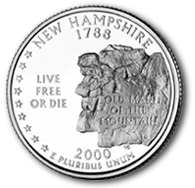Old Man of the Mountain
|
|
This article is about the New Hampshire landmark. For the leader of the Hashshashin who was also known as "The Old Man of the Mountain," see Hasan-i Sabbah.
Missing image Old_Man_of_the_Mountain_overlay_2.jpg A composite image of the Old Man of the Mountain created from images taken before and after the collapse. |
In the United States, the Old Man of the Mountain, also known as the great stone face, was a series of five granite cliff ledges on Cannon Mountain in the White Mountains of New Hampshire that, when viewed from the correct angle, appeared to be the jagged profile of a face. The profile was 40 feet tall and 25 feet wide.
On May 3, 2003, despite many attempts through the years to keep it together, the formation collapsed to the ground. Centuries of wind, snow, and rain, as well as freezing and thawing cycles finally caught up with the profile.
Dismay over the collapse was so great that people left flowers at the base of the cliffs in tribute; some state legislators sought to change New Hampshire's state flag to include the profile; and many people suggested replacing the Old Man with a plastic replica - an idea that was quickly rejected by an official task force headed by former Governor Stephen Merrill.
On the one-year anniversary of the collapse, the task force unveiled coin-operated viewfinders near the base of the cliff. Looking through them shows how the Old Man used to look.
Face-like stone formations are common around the world, including the famous Napoleon's Nose, in the hills north of Belfast. The Old Man was famous largely because of statesman Daniel Webster, a New Hampshire native, who once wrote: "Men hang out their signs indicative of their respective trades; shoe makers hang out a gigantic shoe; jewelers a monster watch, and the dentist hangs out a gold tooth; but up in the Mountains of New Hampshire, God Almighty has hung out a sign to show that there He makes men."
The profile, which was 1,200 feet above Profile Lake, was New Hampshire's state symbol for decades. It was put on the state's license plate, state highway-route signs, and on the back of New Hampshire's Statehood Quarter, which is popularly promoted as the only U.S. coin with a profile on both sides. It could be seen from special viewing areas along Interstate 93 in Franconia Notch State Park, where many visitors began leaving flowers after the profile collapsed. The park is located approximately 65 miles north of Concord, New Hampshire.
The formation was carved by glaciers approximately 10,000 years ago and was first discovered by colonial settlers around 1805. For nearly the entire 20th century until its collapse, cables and spikes had been in place to hold the granite slabs together along with cement and epoxy filling its large cracks.
Timeline of the Old Man
- 8000 BC - As part of the Ice Age, glaciers covering New England create the Old Man of the Mountain at Franconia Notch.
- 1805 - Francis Whitcomb and Luke Brooks, part of a Franconia survey crew, are the first white settlers to record observing the Old Man.
- 1832 - Author Nathaniel Hawthorne visits the area and later publishes a short story called "The Great Stone Face."
- 1869 - President Ulysses S. Grant visits the formation.
- 1906 - Reverend Guy Roberts of Massachusetts is the first to notice signs of deterioration of the formation.
- 1916 - Governor Rolland Spaulding begins a concerted state effort to preserve the formation.
- 1955 - President Dwight D. Eisenhower visits the profile as part of the Old Man's 150th birthday celebration. To celebrate the president's tour, Dartmouth College students drape over the Old Man's upper lip to create the image of a mustache.
- 1965 - Niels Nielsen, a state highway worker, becomes unofficial guardian of the profile, in an effort to protect the formation from vandalism and the ravages of the weather.
- 1987 - After years of effort, Nielsen is named the official caretaker of the Old Man by the state of New Hampshire.
- 1988 - A 12-mile stretch of Interstate 93 opens below Cannon Mountain. The $56 million project, which took 30 years to build, was a compromise between the government and environmentalists that sought to protect the surrounding landscape.
- 1991 - David Nielsen, Niels' son, becomes the official caretaker of the Old Man.
- 2003 - The Old Man collapses.
- 2004 - Coin-operated viewfinders are installed to show how the Old Man looked like before its collapse.

